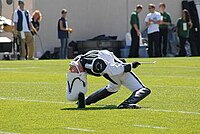Related Research Articles
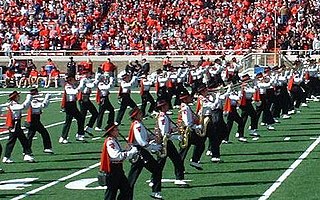
A marching band is a group of instrumental musicians who perform while marching, often for entertainment or competition. They are most popular in the United States, though not uncommon in other parts of the world. Instrumentation typically includes brass, woodwind, and percussion instruments. Most marching bands wear a uniform, often of a military style, that includes an associated organization's colors, name or symbol. Most high school marching bands, and some college marching bands, are accompanied by a color guard, a group of performers who add a visual interpretation to the music through the use of props, most often flags, rifles, and sabers.

Langston University (LU) is a public land-grant historically black university in Langston, Oklahoma. It is the only historically black college in the state and the westernmost HBCU in the United States. The main campus in Langston is a rural setting 10 miles (16 km) east of Guthrie. The University also serves an urban mission, with University Centers in Tulsa and Oklahoma City. The university is a member-school of the Thurgood Marshall College Fund.

The Solid Gold Sound of the UCLA Bruin Marching Band represents the university at major athletic and extracurricular events. During the fall marching season, this 250-member band performs at the Rose Bowl for UCLA Bruin home football games. Pregame shows by the band aim to build crowd energy and enthusiasm with traditional UCLA songs like "Strike Up the Band for UCLA", "Bruin Warriors", and "The Mighty Bruins". Throughout the game, the band performs custom-arranged rock and pop songs, as well as the traditional fight songs and cheers of the university. The UCLA Varsity Band appears at basketball games and other athletic contests in Pauley Pavilion. In 2018, the Bruin Marching Band was featured on the Muse album "Simulation Theory" performing the Super Deluxe version of the song "Pressure."

A drum major or field commander is the leader of a marching band, drum and bugle corps, or pipe band, usually positioned at the head of the band or corps. The drum major is often dressed in more ornate clothing than the rest of the band or corps and is responsible for providing commands to the ensemble, leading them while marching, and directing them what to play, when to play, the dynamic or volume of playing, and what time to keep. The commands may be given verbally, through hand gestures, using a whistle or a baton, or with a mace. Although the drum major is the one conducting for the entire band to see and watch to keep time, the drum major is actually looking at the center snare's feet to keep time. The center snare is the leader of the drumline, and is the one who keeps the band in time while marching. They usually play, tap and/or rolls to set the tempo of how fast the band marches.

The Florida State University Marching Chiefs is the official marching band of Florida State University. The band has served in this capacity since the 1940s and continues to perform at all home football games as well as several away games each year. There are 420+ members, or Chiefs, as members are sometimes known, in the band who hail from almost every academic department within the university.

Ohio University Marching 110 is the official marching band of Ohio University in Athens, Ohio, founded in 1923. The nickname Marching 110 is a reference to the band's original number of members. The 2017 band consists of 240 members. It represents the university at various athletic functions and other events, including over 40 NFL halftime shows.

The Michigan Marching Band is the official marching band of the University of Michigan. The band performs at all Michigan Wolverines football home games, select away games, and numerous concerts, pep rallies, and parades. As a student musical ensemble, the MMB evolved from the original Michigan Band of twenty-two players in 1896 to today's band of over 400 members.
The Pride of Oklahoma Marching Band, known as "The Pride", is the student marching band for the University of Oklahoma Sooners.
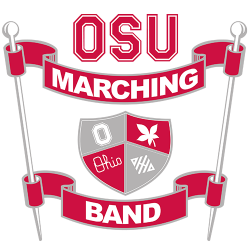
The Ohio State University Marching Band (OSUMB) is a university marching band named for and a part of The Ohio State University. The band nicknamed The Best Damn Band in the Land (TBDBITL), performs at football games and other events during the fall semester. It is one of the few collegiate all-brass and percussion bands in the country, and sometimes deemed the largest of its type in the world.

The University of Massachusetts Minuteman Marching Band (UMMB) is the marching band for the University of Massachusetts Amherst known for its drum corps style and nationally renowned percussion section. The Minuteman Band is also known for its use of dance routines, vocalists, electronics, and overall showmanship.

Whetstone High School is a public high school located at 4405 Scenic Drive in Columbus, Ohio. It is a part of Columbus City Schools and the neighborhood of Clintonville. Whetstone's mascot is the Brave. The school opened in 1961 to accommodate the overflow from North High School. The expanding student base brought on by growth in north Columbus created the need for an additional school.
Script Ohio is a musical drill performed by the Ohio State University Marching Band during pregame celebrations at Ohio State University American football games. First executed in 1936, it has been credited as the earliest example of "moving script writing" by a marching band and has been variously described as "one of college football's most iconic, longstanding traditions" and among "the most impressive examples of American folk art in existence". The maneuver is performed to the Robert Planquette march "Le Régiment de Sambre et Meuse".
The 1963 NCAA University Division football season was played by American football teams representing 120 colleges and universities recognized the National Collegiate Athletic Association (NCAA) as major programs. The remaining 299 colleges and universities that were NCAA members and fielded football teams competed in the 1963 NCAA College Division football season.
The 1976 NCAA Division I football season ended with a championship for the Panthers of the University of Pittsburgh. Led by head coach Johnny Majors, the Pitt Panthers brought a college football championship to the home of the defending pro football champions, the Steelers. Pitt also had the Heisman Trophy winner, Tony Dorsett; the Panthers had been ranked ninth in the preseason AP poll.
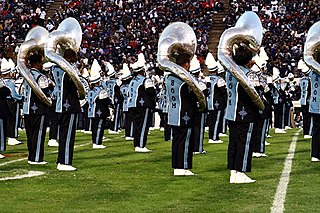
The Sonic Boom of the South is the marching band of Jackson State University (JSU) located in Jackson, Mississippi, US. Dubbed the “Summa Cum Laude of Bands,” its unique style and showmanship have made the Boom one of the most celebrated bands in the world. Often imitated traditions like the J5 drum majors, the Prancing J-Settes, floating JSU, Tiger Run-On, the “Get Ready” entrance, and “The Series” represent the band’s electrifying swagger emulated by many.
George W. Edwards was the director of bands for Prairie View A&M University.
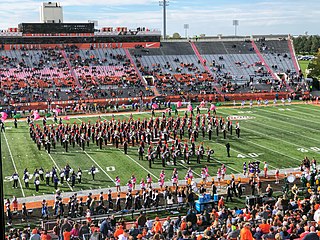
The Falcon Marching Band, known also as the FMB, is the marching band of Bowling Green State University. It features a symphonic sound and chair step marching. Under the direction of Jonathan “Jon” Waters, marching band is the largest student organization on campus. The band performs at all home football games, which are hosted in Doyt Perry Stadium as well as other various university functions.
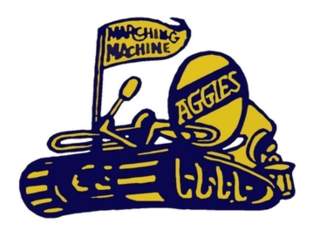
The Blue and Gold Marching Machine is the official marching band of North Carolina A&T State University. The Blue and Gold Marching Machine performs pre-game and halftime shows at all North Carolina A&T Aggies football home games and travels to most away games.
A Historically Black College and University marching band is the marching band sponsored by a historically black college or university. A distinctive "HBCU-style" of marching band originated in the American South in the 1940s through the blending of earlier traditions of military music and minstrel shows with a performance repertoire based on popular song.
References
- ↑ Lindquist, Danille (Autumn 2006). ""Locating" the Nation: Football Game Day and American Dreams in Central Ohio". Journal of American Folklore. 119 (474): 444–488. doi:10.2307/4137650. JSTOR 4137650.
- 1 2 3 Gell, Elizabeth (November 22, 2013). "Get Pumped for College Game Day". Halftime Magazine . Retrieved March 23, 2018.
- ↑ Foster, Emily (2014). The Ohio State University District: A Neighborhood History. Arcadia. p. 32. ISBN 978-1625850324.
- ↑ Thompson, John (January 7, 2016). "Sex, Scandal and the Marching Band: Inside the New Rules at Ohio State". Rolling Stone . Retrieved March 23, 2018.
- 1 2 3 Freed, Ben (November 25, 2015). "Did You Know? The Michigan Marching Band backbend". Ann Arbor News . Retrieved March 23, 2018.
- ↑ Cooke, Shawn (October 24, 2014). "Bend, but no snap: The logistics behind a successful Pitt Band show". Pitt News. University of Pittsburgh . Retrieved March 23, 2018.
- ↑ Wundram, Bill (October 22, 1994). "It's a Blast". Quad City Times . Retrieved March 23, 2018.(subscription required)
- ↑ Lourm, Jake (October 17, 2015). "Michigan fans pack Diag for 'College GameDay'". Dallas Morning News . Retrieved March 23, 2018.
- ↑ "7 Things You (Maybe) Don't Know About the Pride of Oklahoma". ou.edu. University of Oklahoma . Retrieved March 23, 2018.
- ↑ "Sooner Celebrity". OU Daily. University of Oklahoma. September 20, 2004. Retrieved March 24, 2018.
